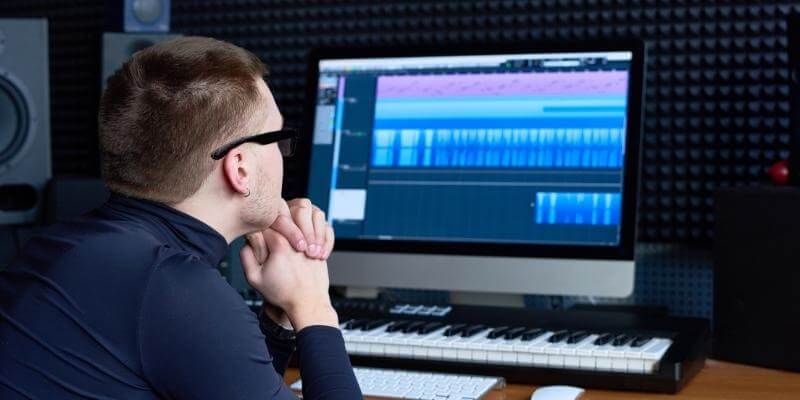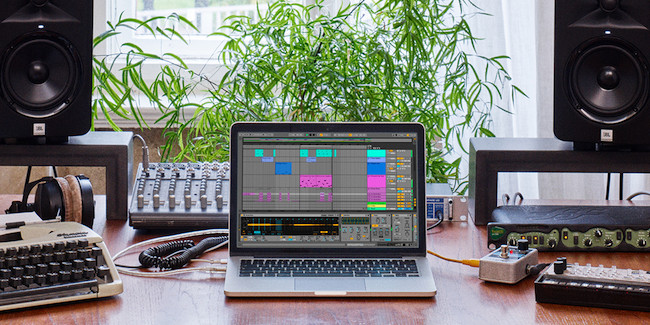
Best Mac for Music Production: People who are creative seem to love Macs. They are reliable, look great, and don’t get in the way of the creative process. They are a great choice for people who like to get creative with sound, and you can find them in many recording studios.
That doesn’t mean PCs can’t be used. Before making a final choice, you should think about what you need, both in terms of software and hardware. There are more kinds of PCs to choose from, they start out cheaper, and many people already know how Windows works.
But you’re reading this review because you’re thinking about getting a Mac, which is a great idea. There is a lot of software and plugins for the platform, and the system is pretty stable. They are also long-lasting and of high quality.
Which Mac should you pick? We only look at current Mac models in this roundup, but we look at all of them. At the moment, the iMac 27-inch and MacBook Pro 16-inch give you the most value for your money without sacrificing performance.
Both have good enough specs to make working with music production software easy, and both have a lot of screen space so you can see what you’re doing as you scroll through all your tracks. They have enough ports for your accessories and enough storage space for the audio projects you are currently working on.
But you might also be happy with a different Mac. We’ll show you all the options and tell you what’s good or bad about each one when it comes to music production.
5 Best Mac for Music Production

1. MacBook Air 13-inch
The 13-inch MacBook Air is the youngest Mac that Apple makes. It’s small in size and costs little. Even though it doesn’t have the specs we recommend, it does meet the requirements of a lot of audio software. If your needs are simple, like recording a podcast or making simple music, the MacBook Air can do everything you need and is easy to carry around. Just add a USB microphone and an app.
At a glance:
- Memory is 8 GB, and storage is 256 GB SSD. The screen is 13.3 inches and has a Retina display (512 GB recommended),
- Apple M1 chip is the processor,
- The 3.5 mm jack for headphones,
- There are two USB-C Thunderbolt 4 ports.
Many audio programs will work on the MacBook Air, especially if you don’t use too many tracks and plugins. It meets the minimum requirements of Garage Band, Logic Pro X, Adobe Audition, and Cockos REAPER, which is a powerful and inexpensive alternative that should be better known.
Apple has only put 8 GB of RAM in a MacBook Air with 512 GB of SSD storage. If you don’t need much and don’t have too many tracks to work with, that should be more than enough. You could also use an external SSD, but it won’t be as fast as one that’s built into the computer.
A lot of successful producers on the Ableton subreddit use MacBook Airs. By freezing tracks, you can reduce the load on your RAM and CPU when you need to. This temporarily records what your plugins are doing to audio so that they don’t have to run dynamically, which frees up system resources.
This is the least expensive and most portable MacBook you can buy right now. It’s great that the battery lasts for 18 hours. It will be good for a lot of people, especially those on a tight budget. But it’s a trade-off for people who want the lowest price or the most portability.
Also, Read- Best Internet Speed Test for 2023: Where to Test Your Internet Speed
2. MacBook Pro 13-inch
The 13-inch MacBook Pro isn’t much thicker than a MacBook Air, but it can do a lot more. Its configuration options mean you don’t have to give up anything. It’s great that the battery lasts for 20 hours. It’s a good choice for people who need more power than the Air but less portability than the 16-inch MacBook Pro.
At a glance:
- The Retina screen is 13 inches,
- Storage: 256 GB or 512 GB SSD, Memory: 8 GB (up to 24 GB),
- Apple M2 is the processor.
- The 3.5 mm jack for headphones,
- Two Thunderbolt 4 ports are available.
The 13-inch model is from a different generation than the 16-inch MacBook Pro that just came out, so it can’t be spaced as highly. Still, most audio professionals will find that it has more than enough power and storage space for their needs.
You might feel a little cramped on the smaller screen, but some people will find that the extra portability is worth it. If you always use the same computer in your studio, you might want to get an extra monitor.
Amazon only offers a small number of configurations, and if you want more than 8 GB of RAM, you’ll have to look elsewhere. It’s important to know this because you can’t add more RAM later. Even though the machine can be set up with a 2 TB SSD, the largest one that Amazon sells is only 512 GB.
3. iMac 21.5-inch
If you don’t have much room on your desk, you might like a 21.5-inch iMac better than its 27-inch sibling. It has the same number of USB and USB-C ports on the back and many of the same configuration options, but you can’t take the specs quite as high.
You do get a smaller screen that will fit on a smaller desk, but you’d have to have very little room on your desk to choose this option. I find that a big screen makes it much easier to work with audio, especially when there are a lot of tracks.
At a glance:
- The screen is 21.5 inches and has a Retina 4K display.
- Storage: 1 TB Fusion Drive, Memory: 8 GB (recommended: 16 GB),
- The processor is an 8th-generation, 3.0 GHz Intel Core i5 with 6 cores.
- The 3.5 mm jack for headphones
Ports: Two Thunderbolt 3 (USB-C) ports, four USB 3 ports, and Gigabit Ethernet.
The 21.5-inch iMac has a lot of the same advantages as the 27-inch model, but it costs less. But there are other differences besides the size of the screen. You don’t have as many options for how to set it up, and, as you’ll see below, you can’t upgrade as many parts after you buy it.
The USB and USB-C ports are hard to get to, just like on the larger iMac. If you are always plugging and unplugging devices, you might want to get a hub that is easier to reach (we covered a few earlier in the review).
But you can’t add more RAM to it like you can with the 27-inch iMac. So choose wisely. Amazon only has 8 GB models, so if you need more space, you’ll have to look elsewhere. Amazon doesn’t sell any models that have an SSD either. Even though you can change that later, it may be cheaper to buy it already set up the way you want it the first time. Or, you could use an external USB-C SSD that is slower.
Lastly, if you’re thinking about the 21.5-inch model because you don’t have a lot of space and want something that’s easier to carry around, you should also think about the 16-inch MacBook Pro. It has great features and is even easier to carry around.
4. iMac Pro 27-inch
Is your motto “No compromise”? Then this machine might be what you need to make music. The iMac Pro looks just like the regular 27-inch iMac, but it has a cooler “space grey” finish and a lot more power inside. It’s also very expensive, but if you make a lot of money working with sound, that might be an easy choice.
At a glance:
- 27-inch Retina 5K display, 32 GB memory, 1 TB SSD storage, 3.2 GHz 8-core Intel Xeon W processor,
- The 3.5 mm jack for headphones,
- Ports: 4 USB, 4 Thunderbolt 3 (USB-C), and 10Gb Ethernet.
Mark Wherry of Sound On Sound wants to know if the iMac Pro is the computer that musicians and audio engineers who use Macs have been waiting for. He comes to the conclusion that it might be if you’re willing to pay for it.
They are pricey and most music producers don’t need them. When MacProVideo asked their readers if the iMac Pro would become the center of their music studios, most of them said no, and almost all of them said it was because of the price. Most music producers don’t need to spend a lot of money on a Mac.
But if a music producer is successful, they can make more than enough money to pay for it, and all that power can make a big difference in their daily work. According to the article in Sound On Sound, Grammy-winning record producer Greg Kurstin found it to be very fast and all he needs to do a whole production. He is used to using a Mac Pro!
This brings us to another option, which is even more expensive. I didn’t include Mac Pros in this review because they have more features than most music producers need, and because they’re new and not widely available yet (like not on Amazon). But they work well and are good for high-end studios.
MacWorld says that “if money is no object,” the Mac Pro is the best Mac for musicians. When Ask. Audio asks, Is the new Apple Mac Pro the best computer for making music? They sound interested and mention that Apple has hinted at a new version of Logic Pro that will work better with all that power. Can you afford one?
5. Mac mini
The Mac mini’s specs went up a lot. Does this small computer now have enough power to do serious audio work? According to tests, it does. It has higher Geekbench scores than an older Mac Pro, and the team had no trouble using 128 tracks and a lot of plugins with it. It’s a good choice if you want a computer for music that doesn’t take up much space.
At a glance:
- The monitor is not included.
- Storage: 512 GB SSD, Memory: 8 GB (recommended: 16 GB),
- The processor is an 8th-generation, 3.0 GHz Intel Core i5 with 6 cores.
- The 3.5 mm jack for headphones,
- There are four Thunderbolt 3 (USB-C) ports, two USB 3 ports, an HDMI 2.0 port, and a Gigabit Ethernet port.
If you go with a Mac mini, you’ll also need to buy a separate monitor, keyboard, and mouse, as well as any audio accessories you need. That’s not all bad, though, because it lets you pick the ones that work best for you. With other Macs, you have to use the monitor that comes with the computer.
There are a lot of ports on the Mac mini for your audio interface, MIDI controllers, and other devices. It has the same processor as an iMac, which can be upgraded to a 6-core i7 at 3.2 GHz.
Amazon doesn’t offer that configuration, though. They only have 8 GB of RAM and a 256 GB hard drive. There should be more of each. The RAM can be upgraded at an Apple Store, but the SSD is soldered to the logic board and can’t be changed. An external SSD is your only choice, but it’s not as fast.
Using a Luna Display dongle, you can connect an iPad to the mini so that it can be used as a screen. And since we’re talking about iPads, they can be used to work with sound on their own.






